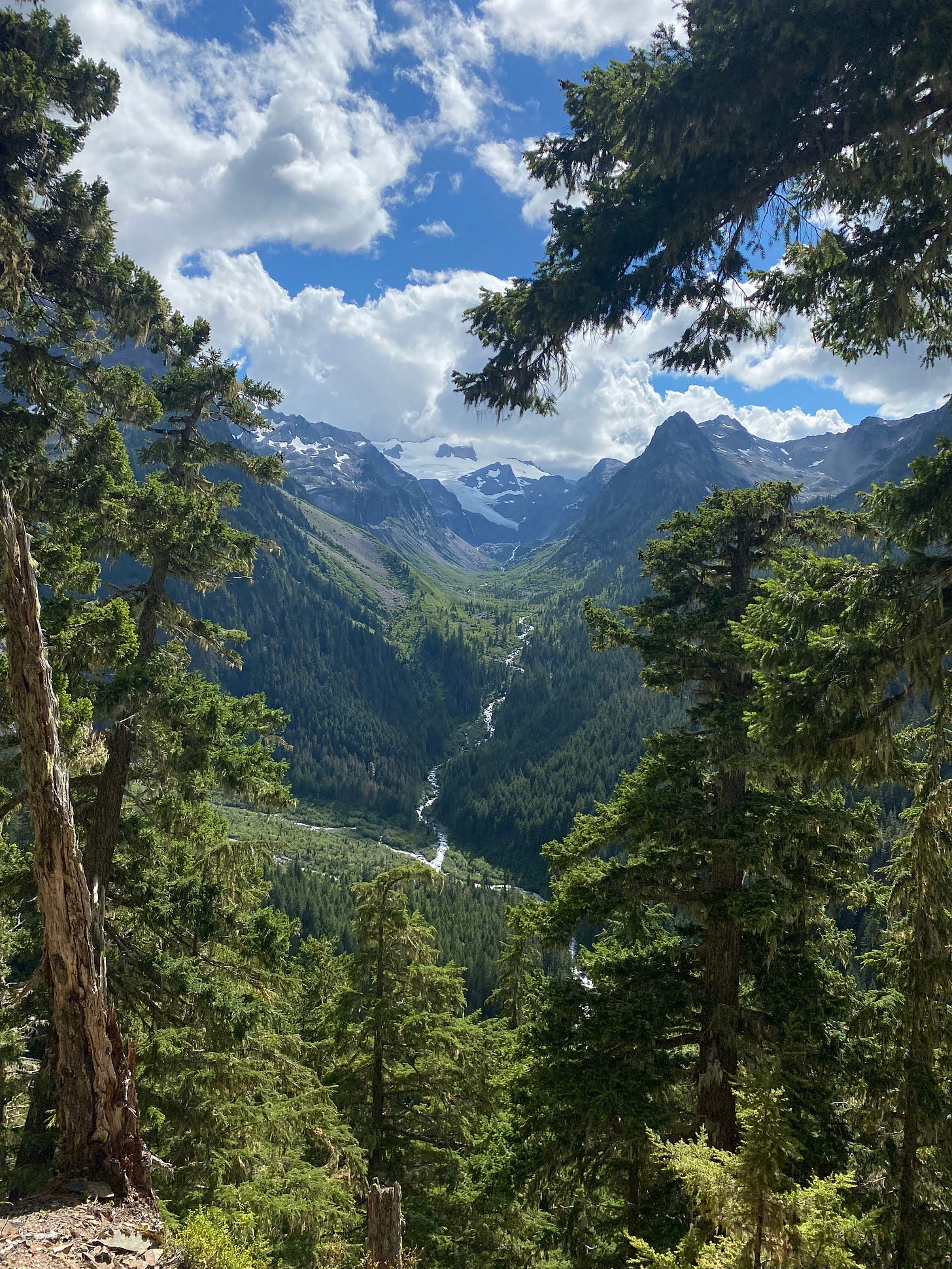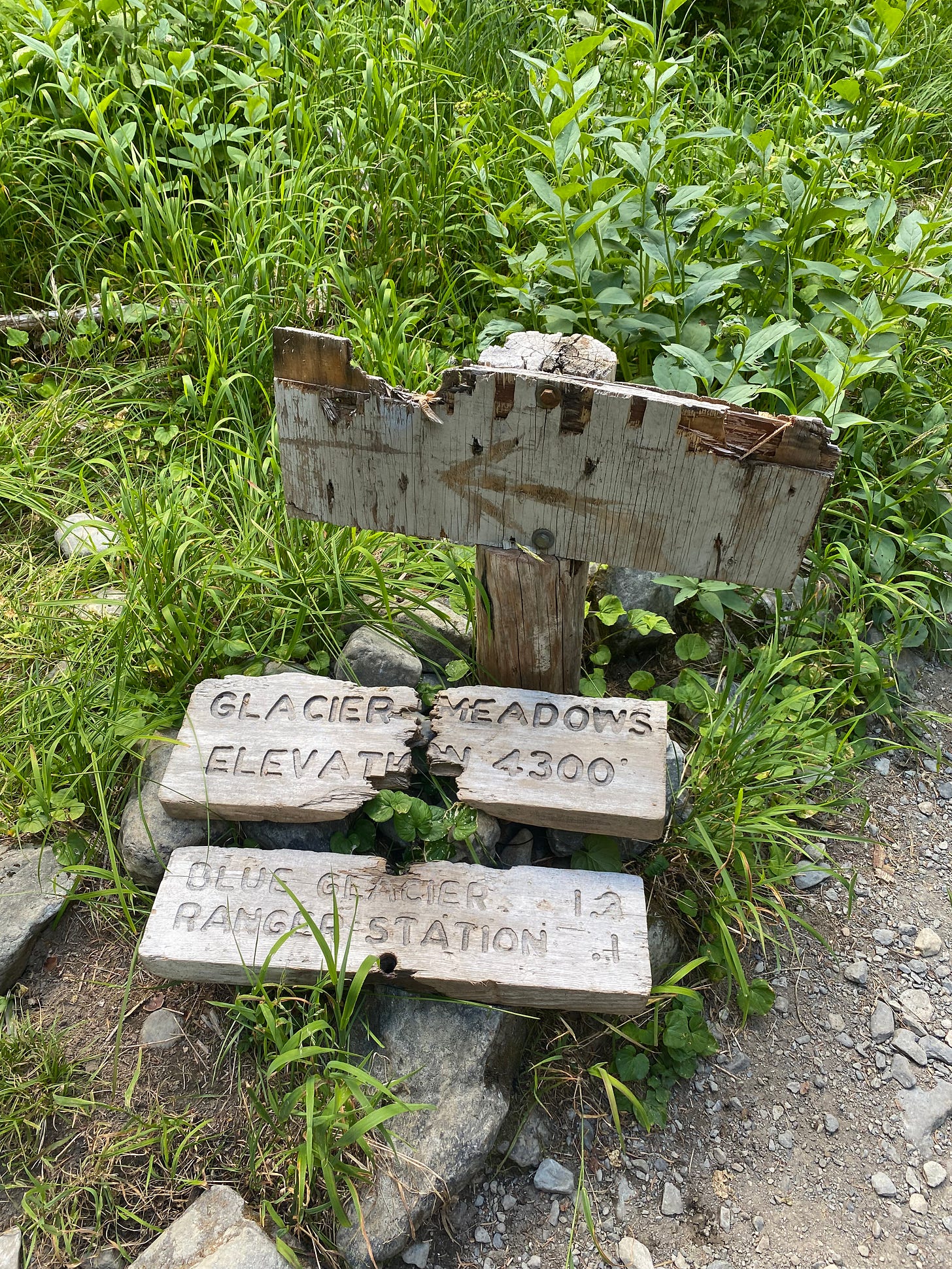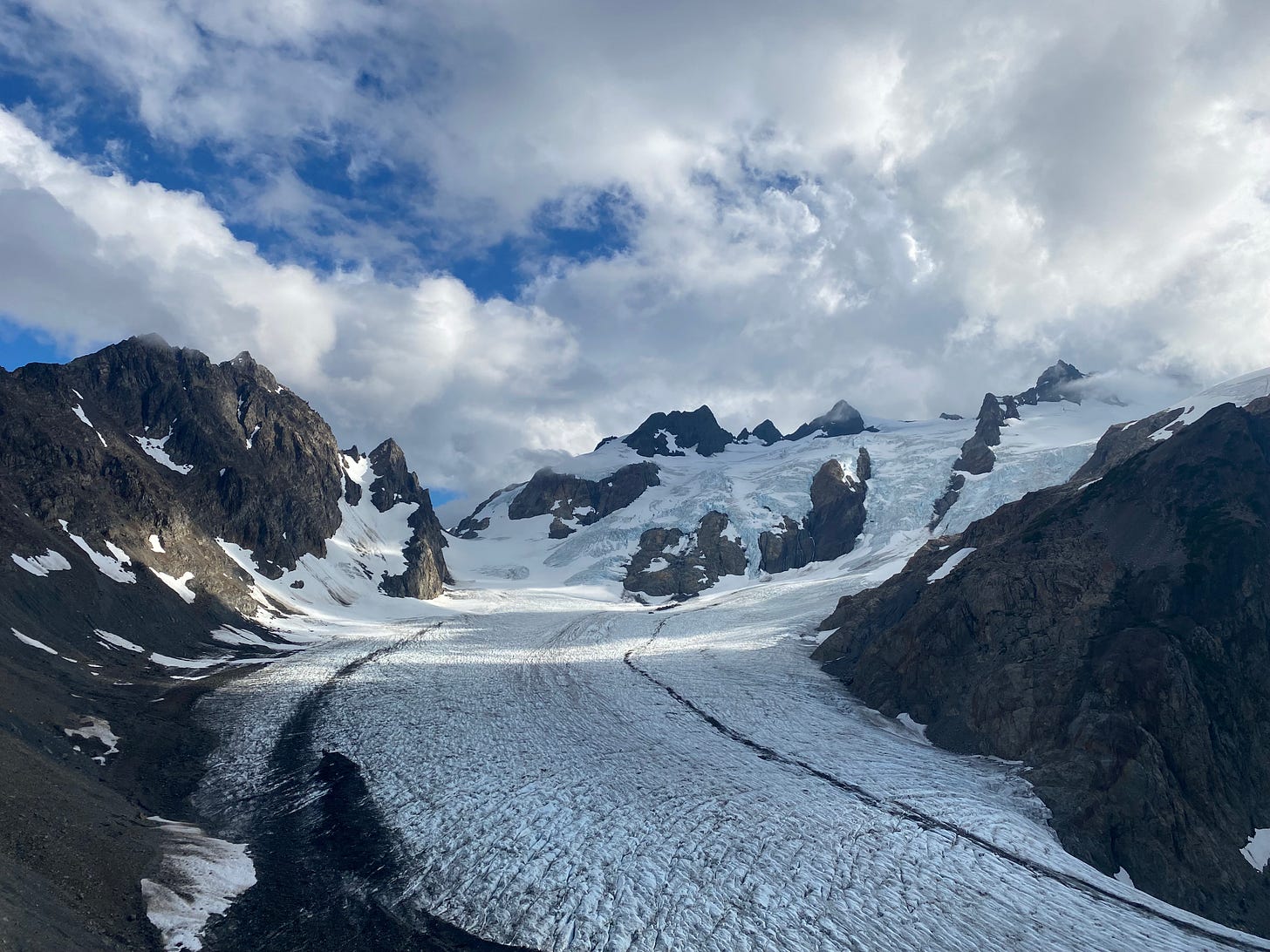When morning came, I was one of the only people left in the campground. I immediately checked the outhouse. The bag had been moved from one side of the toilet to the other, but was otherwise intact. No bear or rodent infestation. The next thing I did was to take my bag and practice clipping it onto one of the now vacant clips on the bear wire. In the daylight, the mechanism was perfectly clear.
Eager to begin my big day to the glacier, I sauntered back to my campsite and had an enjoyable sencha tea session, another one of my luxury-weight items, almost completely alone in the rainforest. Huge black ants trawled the dirt. After filtering my water I briefly talked to a couple of 60s-ish women who had done the day hike from Lewis Meadows to the Blue Glacier the previous day—my plan. It was about 10:30 AM.
“Oh, you need to get going. It took us 13 hours,” one of them said earnestly.
I had my tea and started mentally preparing. It was going to be a very long day. I propped my feet up on a rock and attempted to recover my senses. I thought about the first real backpacking trip I had ever done, almost 21 years ago. I was about to start my freshman year at Harvey Mudd College. As part of an optional Pre-Orientation activity, incoming freshman could sign up to do a backpacking trip. We went to Kings Canyon National Park, along the eastern Sierra Nevadas of California.
We were put into several small groups with two upperclassmen leaders apiece. I thought the trip would be a fun bonding experience, and the beginning of a glorious time, followed by a real life, Real Genius college experience. Things went wrong from the outset.
The ancient external frame backpack my dad had lent me didn’t fit well, and hurt my shoulders. One of our leaders got altitude sickness after the first day and had to go back. Another of our group members was a scary Russian guy who chain smoked and threw knives at each camp site. A couple days in, another person had a mildly allergic reaction to a bee sting. I began to hate trail mix.
This trip did a great job at turning me off to backpacking for a long time. Appropriately, the brutality of the curriculum and level of expectations at Mudd was about to do the same thing to me and many others over the next few years. But I didn’t know that yet.
I did a few other camping trips during college, both with people I knew, and some I didn’t. None of them ended entirely well, mostly due to the poor planning of college students.
One trip was to Joshua Tree National Park. I should have noticed it was a bad sign that the driver’s trunk had to be partially fastened with rope. The engine started to die just as we made it to the entrance of the park, right before sunset. We clambered around the surreal trees and strange landscape for a few hours, and then rolled back down the hill to the edge of the scruffy town of Joshua Tree. The mechanic wasn’t open until the next day, so we slept on the outskirts of town, between spiky bushes and pieces of garbage. I spent the next day brooding, while we waited for a ride.
Although I made a few local excursions to local Mount Baldy over the years, it wasn’t until a few years later that I started to embrace the outdoors again. I moved to the San Francisco Bay Area and discovered Point Reyes National Seashore. It was only a short drive from a huge urban area, yet felt a world apart.
Sky Camp was a moderate 1.5 mile hike in, enough to keep away the overly casual visitor, but not so much to be demanding—it even had bear lockers. I loved to stay a couple nights, and hike down to the remote beaches, watching the quail dart in and out of bushes, with their laser-like chirps. One time I encountered part of a deer carcass that had recently been visited by a mountain lion.
It was time to go. I took only what I needed for the day: a modest amount of food, water, and safety supplies. It was about noon when I began walking. I thought I could make it back by 8 or 9. It was about 8 miles each way and 4000-5000 feet up, depending on where you stopped counting.
I set off, breathing solely through my nose. As an aspiring pulmonaut, I’ve experienced the power of breath firsthand through my years as a martial artist. The founder of my style of aikido frequently demonstrates his ability to breathe out continuously and loudly while throwing people, all without ever inhaling, for up to a minute at time. Other masters demonstrate a similar command of their lungs and its connection to what’s sometimes known as “internal power.”
Reading the book, Breath: The New Science of a Lost Art, only confirmed these points. Specifically, studies have shown that breathing in less air, paradoxically, actually leads to a more optimal balance of gases within the bloodstream, as well as building more efficient lungs. Breathing through the nose rather than the mouth has almost too many benefits to name, while mouth breathing seems to contribute to skull deformities, respiratory problems, and harmful bacterial load.
So, I was steadily ascending towards a glacier, at as quick a pace as I could muster for many hours, while breathing as slowly as possible, and finding myself with a newfound stamina. Another aiki lesson is: project towards the ends of the universe. When faced with an opponent, your intention and force doesn’t end at their body, but rather on the other side of the room, through them. I was only facing myself, and I knew my end point wasn’t for a long time, so I projected my energy through the other side of the mountain, and further off glaciers.
Eventually I came to the dreaded rope ladder. It requires one to descend on the way up the trail. It consists of two long steel cables along the side of a sheer cliff, cut up by large wooden pegs. It was maybe 100 feet down, and I held onto every step. This was the single most terrifying part of the entire journey. When I got to the bottom, my entire body was quivering, and I had to sit down for a bit.
As I went higher up, and the trail became sharply more vertical, the views became more epic, and I began to ride waves of exhaustion. I carried a little bag of salt that I periodically licked with my water, to account for excess electrolyte loss. I nibbled on nuts, chocolate, and dried fruit, but tried to minimize my sugar to avoid crashing.
At one point the path narrowed, hewn in by berry bushes from all sides. I checked to see if any were recently eaten, which could indicate bear activity. Further up, a thin stream gently pulsed through pebbles, and I looked down to see tiny little frogs everywhere, jumping around, and tried not to step on any.
I passed by the highest and final campgrounds, just small clearings cut out of the dense mountain side. The privies were crude. I nodded hello to a group of men by their tents, but they just stared at me before returning to their muted conversations. I stopped to talk briefly to a Japanese guy and his family totally specced out in gear like they were on safari, and receiving a disapproving “Hmm, very far,” when I told him where my camp was.
The trail disappeared, and a giant pile of rocks lay in front of me, and above me. And then more rocks. I knew that however tired I was and how far I had to return, I had to make it to the viewpoint, because it would give me the spiritual sustenance to return. Finally, I made it to the end. A huge glacier lay in front of me on the other side of the cliff, and no one was around. It was magnificent, yet I couldn’t help remembering that, “there’s very little zen on the tops of mountains,” as Robert Pirsig wrote.
For the first time on this trip, I felt a little cold, and the clouds seemed to gather all around the edges of the mountains. I took it all in then started eating my snack, which also ended up being most of my food for the rest of the day: some bread and trail mix, a boiled egg, and a few pieces of beef pepperoni. It was nearly 6 PM.
After talking briefly with a mountaineering Russian family from NY that had just climbed up and down the whole glacier, I started to make my way down. My goal was to make it back in one piece. I knew I had hours to go, and that a sustainable and smooth pace was key. Although it wasn’t yet dark, the rainforest quickly began to swallow the light. I switched on my headlamp and had spare batteries ready. As the light faded, I somehow ended up one side of a river crossing too far upstream. It was only a short distance, but I needed my GPS app to get reoriented, and climb over some trees and boulders. It’s so easy for the wilderness to destroy you.
After a while, it was clear that I was going to have to do what I had been trying to avoid: go back in the dark. I put my headlamp at full intensity and aimed it at the ground. The main thing was to avoid tripping on any tree roots or rocks. After 8 PM, there was absolutely no one anywhere on the trail. I continued to sing and call out as many sounds and songs as I could muster. The light from my lamp was so puny compared to the darkness all around me, I no longer attempted to even look around. If a bear or a mountain lion was going to suddenly appear, so be it.
I felt very tired and had approximately half a bar left. The shadows from my lamp began to have a strange hallucinatory effect on my senses. Periodically I would check my GPS and see how far I had to go. It always seemed a lot further than I hoped. Finally, at around 9:45, I stopped—there was a giant frog in the middle of the path. My light illuminated it perfectly. It seemed completely calm and unmoving. I knew then that I was going to make it back all right: it was encouraging me, like a spirit guide.
Another 40 minutes later or so, I strolled back into my camp. I stuffed some food in my mouth and looked up at the night sky, feeling accomplished. A mouse scurried up and down my backpack, looking for food. I slept well.
The next day I returned back the same way, with some difficulty. I was filled with joy and exhaustion, but still had 11 miles to go. Exiting is also part of the journey. I encountered a number of other backpackers coming in, chatted with them and revisited some of the spots I had been just 2 days before. Once I saw day hikers again, I knew my journey was basically over. They didn’t seem transformed.








Great adventure! That photo of the valley between the trees is incredible!
Great photos. Just discovered your page!